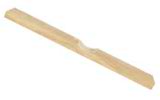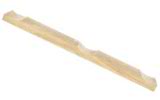The Structure of the Marimba
[Experiment2]Tone plate sanding location and sound pitch experiment
Performing a sound experiment
Sanding down the central portion of the underside of the tone plate makes the note lower. What would happen if the ends were sanded down, instead? Try it and see.
Experiment steps
- Have the wood (after sanding it down to the "even more" stage) from the previous experiment ready.
- Try sanding down the two ends along the perimeter of the wood, at the nodes.
- Strike the top side with a mallet and listen to the sound.
Experiment results
Before sanding down both ends

After sanding down both ends

*Note: As this was an experiment, the recorded pitches differed from the correct notes.
Sanding down the ends makes the note higher!
Upon sanding down the ends of the tone plate, the note went up a semitone, from a G to a G♯. However, in contrast to how the note kept falling by sanding just a little bit, sanding the portions further out toward the perimeter of the bar, near the nodes, does not raise the note to nearly the same extent. Furthermore, doing only one end will not raise the pitch of the note. It is only after sanding both ends that a change of around a semitone occurs. With an actual marimba, the player does not sand down the ends of the bars to adjust the pitch of the notes; the bars are left thick.
Musical Instrument Guide : Marimba Contents
Origins
Structure
- What kind of instrument is the marimba?
- Inside and outside the resonator pipes
- There is craft to the design of the tone plates, too
- [Experiment1]Tone plate sanding depth and sound pitch experiment
- [Experiment2]Tone plate sanding location and sound pitch experiment
- [Experiment3]Try changing the material of the resonator pipes
